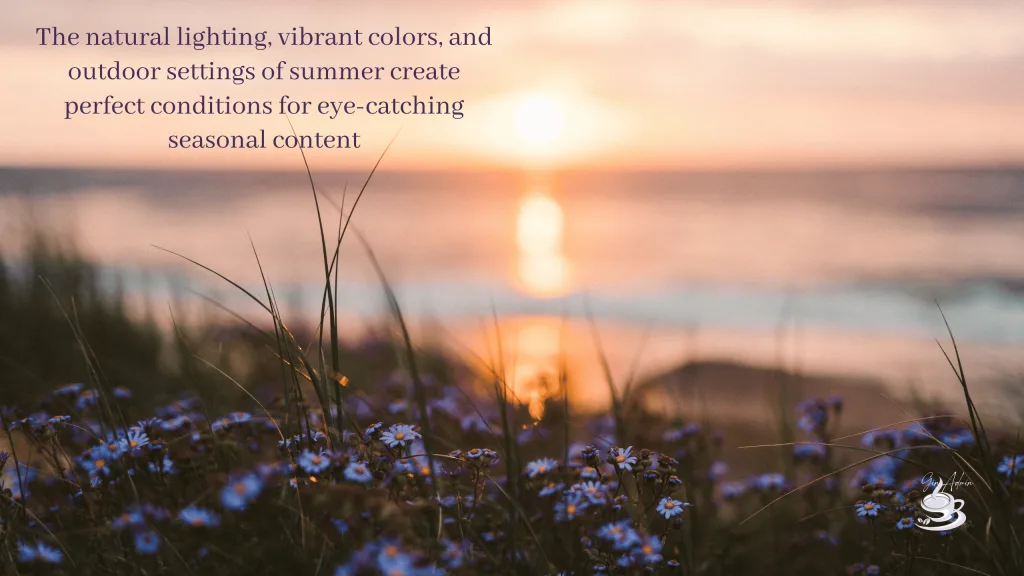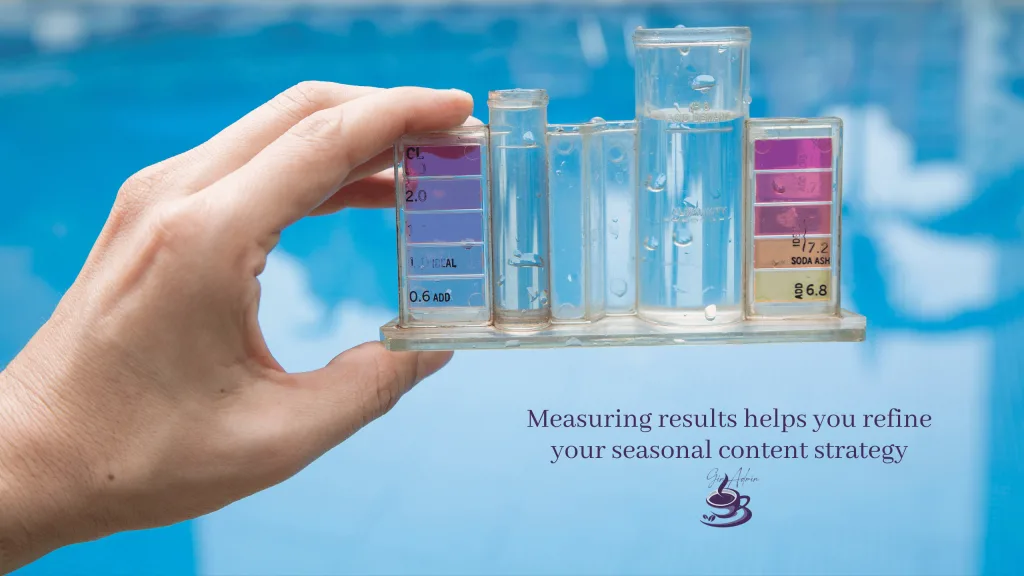Hey there, content creators!
Summer is just around the corner, and if you’ve been scratching your head wondering how to freshen up your content for the warmer months, you’re in the right place.
Let’s look at some seasonal content strategies that will help you make the most of Summer trends and keep your audience engaged when temperatures rise.
Why Seasonal Content Matters in Your Overall Strategy
If you’ve been following me for long, you know that creating fresh, relevant content all year round can feel like a never-ending marathon.
Seasonal content gives you natural opportunities to connect with your audience in ways that feel current and timely.
When you align your content with what’s happening in the world around us, you tap into conversations and interests that are already buzzing.
The beauty of this is that it works with our natural rhythms.
And if you’re at all like me, you change your wardrobe with the seasons.
We also change our interests, needs, and our online behaviors shift too.
During summer, people are searching for different things than they were in winter.
From vacation ideas to outdoor activities to refreshing recipes (helloooo Pina Colada!).
By tuning into these seasonal shifts, your content becomes more relevant and valuable at exactly the right moment.
Plus, creating seasonal content doesn’t mean starting from scratch every few months.
It’s like refreshing your core topics through a seasonal lens.
This will help you to stay consistent with your brand while keeping things interesting for your audience.
Summer, The Content Goldmine
The summer months bring longer days, more outdoor activities, and a general shift in lifestyle that affects how people consume content.
With more people taking vacations, spending time outside, and breaking from routine, their content needs and consumption habits change dramatically.
This seasonal shift creates perfect opportunities for content that feels relevant to their current experiences.
What makes seasonal content for summer so effective is its timeliness.
When your audience sees content that acknowledges their current reality, they’re more likely to engage with it.
Like dealing with the summer heat or planning activities for kids who are out of school.
It’s like you’re reading their minds by addressing exactly what they’re thinking about right now.

Major Summer Events
Summer is packed with events that can anchor your content calendar.
Instead of just mentioning these events in passing, let’s look at how you can create meaningful content around them that will resonate with your audience.
The Fourth of July celebrations offer more than just an opportunity to post a flag graphic
Content that explores modern celebrations, community events, or even the history of independence from fresh angles.
Or create practical content like “Last-Minute Fourth of July Ideas That Will Save Your Holiday” that solves real problems for your audience.
Summer travel season hits its peak in July and August
With more people prioritizing sustainable travel and unique experiences over traditional tourist destinations, there’s room for content that guides people through these new priorities.
Creating content about under-the-radar destinations, tips for traveling more sustainably, or how to capture amazing travel content for their own social media will draw their attention.
By late summer, the back-to-school season begins ramping up
This transition period creates anxiety for many parents and students.
This makes it perfect for supportive content that helps ease this seasonal shift.
Not just basic supply lists.
But content about managing that emotional transition from summer freedom to school structure.
Or even tips for creating social media-worthy first day moments.
Tapping Into Seasonal Search Trends
One of the smartest ways to plan your seasonal content strategy is by understanding what people are actively searching for.
Summer brings specific changes in search behavior that you can leverage to create highly relevant content.
Food-related searches see massive seasonal shifts in summer.
Searches for grilling tips, cold beverages, and no-cook meals skyrocket when temperatures climb.
Creating content around summer recipes doesn’t just mean sharing a basic recipe.
People are looking for meals that won’t heat up their homes, dishes that work for outdoor gatherings, and ways to use abundant summer produce.
Your content can solve these specific seasonal challenges.
Health and wellness searches also follow predictable seasonal patterns in summer.
Hydration tips, sun protection advice, and natural remedies for summer ailments see huge search volume increases.
Creating content that addresses these specific summer health concerns positions you as a helpful resource exactly when your audience needs these solutions.
The best part about focusing on seasonal search trends is that they’re somewhat predictable year to year.
While specific trends evolve, the general categories of summer searches remain relatively stable.
This means that you can plan your content calendar well in advance, knowing what general topics will be in demand.

Visual Opportunities for Stunning Seasonal Content
Summer provides unmatched visual potential for content creators willing to take advantage of it.
The natural lighting, vibrant colors, and outdoor settings of summer create perfect conditions for eye-catching seasonal content.
The golden hours of summer, those magical, colorful times around sunrise and sunset, last longer and offer stunning natural lighting for photos and videos.
Planning outdoor content shoots during these times can enhance your visual content with minimal effort.
Even smartphone photos can look professional with this beautiful natural lighting.
Color psychology plays an important role in content too.
Summer’s bright, saturated colors naturally evoke feelings of energy, happiness, and abundance.
Incorporating these seasonal color palettes into your visual content, whether it’s your Instagram grid, blog images, or video content helps trigger those positive summer associations for your audience.
Don’t overlook the power of showing seasonal activities in action.
Content that showcases people enjoying summer adventures, relaxing by water, or gathering for outdoor meals taps into aspirational seasonal desires.
These visuals can be particularly powerful for brands whose products or services enhance summer experiences.
Platform-Specific Summer Trends
Different platforms experience different seasonal trends.
Understanding these patterns can help you optimize your summer content strategy for each channel.
On TikTok, summer challenges and trends typically revolve around outdoor activities, summer transformations, and seasonal music.
The platform’s quick format works perfectly for before-and-after content (think garden makeovers or summer fashion transitions) and tutorial content for seasonal activities.
Creating content that incorporates trending summer sounds can significantly boost your visibility.
Pinterest typically sees massive increases in searches for summer projects, outdoor space design, and seasonal entertaining ideas starting as early as April.
The platform’s users are planners, often looking for seasonal inspiration months in advance.
Creating comprehensive, visually rich seasonal content for Pinterest could mean developing pin-worthy content about summer garden ideas.
Or maybe outdoor entertaining spaces, or summer capsule wardrobes.
Instagram’s summer trends tend to focus on aspirational experiences and aesthetics.
Travel content, summer fashion, and beautiful outdoor settings dominate the platform during warmer months.
Your seasonal content strategy for Instagram might include creating a consistent summer aesthetic for your grid.
Maybe showcase seasonal lifestyle content, or developing Instagram-specific summer series that your followers can look forward to.
Understanding these platform-specific seasonal trends allows you to adapt your core summer content to perform best on each channel rather than taking a one-size-fits-all approach.
Creating a Flexible Seasonal Content Calendar
Now let’s talk about how to organize it all into a workable plan.
Creating a seasonal content calendar doesn’t mean rigidly planning every post months in advance.
It means developing a flexible framework that allows you to capitalize on seasonal opportunities while maintaining consistency.
Start by mapping out the major summer moments from June through August.
Include obvious holidays, industry events relevant to your audience, and seasonal transitions.
Think the start of summer break or back-to-school season.
These become the anchors in your content calendar.
Next, consider your content pillars, those core topics that define your brand, and brainstorm seasonal angles for each.
How can your usual content categories be refreshed with a summer perspective?
This exercise often reveals dozens of seasonal content ideas that still feel authentic to your brand.
The most effective seasonal content calendars include a mix of planned cornerstone content and flexible space for responding to emerging trends.
Maybe 60-70% of your summer content can be planned in advance.
Then the remaining 30-40% left open for timely topics that you didn’t see in your crystal ball.
This balance ensures you’re both prepared and responsive.
Remember that seasonal content can be repurposed across platforms and even reused year after year with updates.
Creating modular content that can be adapted for different platforms maximizes your efficiency while maintaining that crucial seasonal relevance.

Measuring your content Success
As with any content approach, measuring results helps you refine your seasonal content strategy over time.
Summer content provides unique opportunities to track seasonal engagement patterns that can inform your approach for future seasons.
Beyond standard metrics like views and engagement, look specifically at how your summer content performs compared to content from other seasons.
Are there particular types of seasonal content that resonate especially well during summer months?
Do certain platforms see bigger seasonal shifts in performance than others?
Pay attention to timing as well.
Summer content often sees different engagement patterns as people’s schedules and habits change.
You might notice weekend engagement drops because…vacation.
Or evening engagement increases as days get longer.
These insights can help you optimize your posting schedule for maximum impact.
The most valuable learning often comes from comparing year-over-year seasonal performance.
After implementing a deliberate summer content strategy this year, you’ll have baseline data to compare against next summer’s efforts.
This creates a continuous improvement cycle for your seasonal content approach.
Creating effective seasonal content for Summer months doesn’t have to be overwhelming.
Start by identifying the summer topics most relevant to your specific audience.
Then select the seasonal events and trends that align naturally with your brand.
Then develop a flexible content calendar that incorporates both planned seasonal content and room for timely additions.
The key to successful seasonal content isn’t just acknowledging the season.
It’s understanding how the season affects your specific audience’s needs, interests, and behaviors.
When you create summer content that truly serves your audience during this unique time of year, you’ll see engagement that reflects that relevance.
Remember that the best seasonal content feels natural, not forced.
As you implement these summer content strategies, keep your brand voice consistent even as your topics embrace seasonal shifts.
This balance ensures your summer content feels both timely and authentically you.
I’d love to hear how these seasonal content strategies work for you this summer!
Share your wins or questions in the comments!
Ready to turn these summer content ideas into reality? Grab my FREE Content Creation Made Easy guide! This resource gives you the templates and shortcuts to implement these seasonal strategies without the overwhelm. Click here to download and make this your best content summer yet!





